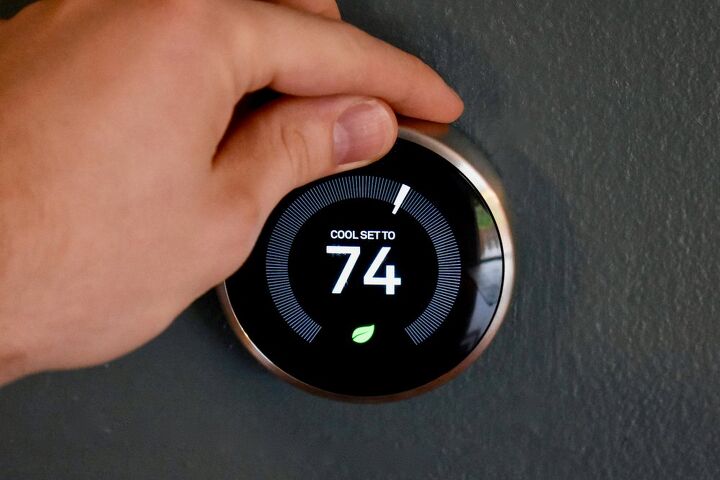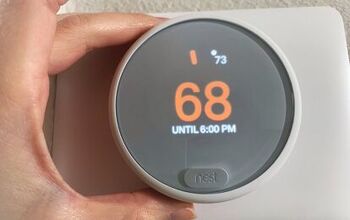Nest Vs. Honeywell Smart Thermostats: Which One is Better?

With an average rating of 4.5 stars, both Nest and Honeywell Smart Thermostats perform well in the eyes of customers. However, they have their differences.
Honeywell has a variety of thermostats—both smart and traditional. Since Nest only offers smart thermostats, it would only be fair to compare them to Honeywell’s smart thermostats.
A Honeywell Wi-Fi Smart Thermostat is roughly $100 cheaper than a Nest Smart Thermostat. Both devices are compatible with most 24-volt HVAC systems. While Honeywell has a touch screen, Nest works with Alexa-enabled devices for voice control. Nest features learning technology that Honeywell does not. Honeywell’s style is more traditional than the contemporary look of Nest.
Do You Need Thermostat Installation or Replacement Services?
Get free, zero-commitment quotes from pro contractors near you.

Price
It’s important to note that prices fluctuate all the time. That being said, Honeywell Smart Thermostats are just about $100 cheaper than Nest.
Honeywell’s Wi-Fi Smart Thermostats average $137 on Amazon. The chart below details the cheapest and most expensive versions of Honeywell Smart Thermostats.
| Thermostat | Price |
| Honeywell Home RCHT8612WF T5 Plus Wi-Fi Touchscreen Smart Thermostat | $109.98 |
| Honeywell Home Honeywell THX321WFS2001W T10 Pro Smart Thermostat with RedLINK | $175 |
Nest 3rd Generation averages $224 on Amazon. With a smart sensor included, the price runs about $287.
The Winner: Honeywell is noticeably cheaper than Nest. Even the most expensive version is still about $50 cheaper.
Size and Style
Beauty is in the eye of the beholder. What is stylish to some might not be to others. Knowing your style will help you decide whether Nest or Honeywell is right for your home.
Nest fits the contemporary aesthetic with its sleek, circular design. On the smaller side, Nest measures a little over 3 inches in diameter, so it won’t be a monstrous eyesore. It does, however, light up when someone enters the room, subtly reminding you of its presence.
Honeywell has a more traditional design. Its rectangular shape falls in line with a conventional thermostat. Depending on the version you choose, the size of the thermostat varies. In any case, Honeywell is bigger by almost an inch, sometimes closer to two.
The Honeywell Home RTH9585WF1004 Wi-Fi Smart Color Thermostat offers the ability to choose the screen color. You can design it to blend in with your décor or stand out.
The Winner: Style is a preference, so it’s a tie there. As for size, Nest wins with its smaller “out of sight, out of mind” design.
Features
Yes, it’s nice to picture what our thermostat might look like in our home, but what can it actually do? We want our smart thermostats to be smart, which means we need to understand how their technology will benefit us.
Nest has a learning program. After tracking your schedules and patterns, Nest learns from you and programs itself! It is compatible with both Google- and Alexa-enabled devices to allow for voice control. Nest jumped on the room sensor bandwagon and now offers them with their thermostats.
Because it wants the thermostat to do the work for you, Nest doesn’t have a touch screen, unlike Honeywell. This makes it slightly more difficult to interact with the thermostat.
Honeywell’s app offers important alerts. The app warns you when your HVAC approaches extreme temperatures. Additionally, it tells you when there’s an unusual spike in the system’s energy. From the app, you also have the ability to control more smart devices than just the thermostat.
The Honeywell Home T9 is compatible with Google Assistant and Amazon Alexa. However, not all Honeywell models have this feature. Additionally, the T9 offers room sensors that detect movement and adjust the HVAC system accordingly.
Both devices offer remote control through their apps.
The Winner: You can’t beat a device that learns your routine. Nest slightly edges out Honeywell in this category. Even if you get a Honeywell model with voice control capabilities, it still can’t program itself.
Compatibility and Installation
Both Nest and Honeywell are designed to replace your existing thermostat and are compatible with 95% of North American HVAC systems.
Honeywell is compatible with a variety of HVAC systems. It supports heat pumps as wells as 2-stage heating systems.
Nest has some degree of portability with its Heat Link Box that connects to your boiler (and wirelessly to your thermostat.) The 3rd Generation can also be fitted with a stand so it doesn’t have to be wall-mounted. Nest supports 3-stage heating systems.
Neither thermostat is compatible with heating systems that use 110V or 220V. These are typically found in systems with baseboard heating.
While Nest tells you a C-wire isn’t necessary, most modern thermostats require a C-wire in order to run properly. It’s possible to install both Nests and Honeywells without a C-wire, but problems are likely to arise. The most common complaints come from Nest users who initially installed their thermostat without a C-wire.
Should you choose to install your Nest without a C-wire, the process is initially quicker and easier than installing a Honeywell. However, you may end up having to redo it down the line if you continue to run into problems.
The Winner: It’s a tie. Nest’s confusing directions about C-wires negate the fact that it’s portable. Most users would rather have a functioning thermostat than a portable one.
Wi-Fi Set-Up
The thing that sets a smart thermostat apart from a traditional one is the Wi-Fi connection. Part of the initial installation is connecting the thermostat to the Wi-Fi. The process is different for Nest and Honeywell.
Connecting Nest to Wi-Fi is relatively easy. After the thermostat is installed, connect it to your Home Network with the Wi-Fi password. Then, download the app, create an account, and register your thermostat. Now, you can remotely control your Nest.
Connecting Honeywell to Wi-Fi is more involved. After connecting the thermostat to your Home Network, register it at mytotalconnectcomfort.com. You should then receive an email prompting you to activate the device and allow remote access. You have to add the MAC ID and Device code to the account before downloading the app.
The Winner: Nest is more user-friendly with its Wi-Fi set-up. There are fewer steps involved and it’s much more straightforward.
Energy Efficiency
Both devices are designed for energy efficiency which can save you 20%-30% on average in energy bills.
Honeywell comes equipped with a Smart Response system. This learns how long your HVAC system takes to reach the temperature set point. It switches on your furnace or AC at exactly the right time so your system isn’t running longer than necessary.
Nest has a motion sensor that activates the HVAC system. If, after 2 hours, it doesn’t detect motion, Nest switches the HVAC system off. Additionally, it switches the system on if it detects motion while in standby mode. This does mean that Nest needs to be placed in a prominent, high-traffic area in order for its efficiency to take full effect.
Nest also gives energy usage reports. These tell you how much energy you’ve used and how efficiently you’ve used it.
The Winner: If installed in a highly trafficked area, Nest beats Honeywell for energy efficiency. It’s heating the home based on recognized occupancy. Honeywell needs to be told when no one is home and the temperatures manually changed to maximize its efficiency.
Nest vs. Honeywell
Here is a side-by-side comparison of the Nest and Honeywell Smart Thermostats.
| Nest | Honeywell | |
| Price | $224 (average) | $137 (average) |
| Size | About 3-in diameter | 3.5+ inches |
| Style | Contemporary | Traditional |
| Programming | Learns your routine and programs itself | Programmable but requires manual changes to schedule |
| Google/Alexa Compatible | Yes | T9 model |
| Installation | Don’t need a C-wire | C-wire usually required |
| Wi-Fi Set-up | Easy and user friendly | Multi-step process |
| Energy Efficiency | Great—Motion sensor turns on system when needed | Good—Manual changes are needed to maximum efficiency |
Related Questions
Does Nest really save money?
Users report an average savings of 10%-20% on their heating bills and about 15% on their cooling bills. This is an average estimated savings of $131-$145 a year. Therefore, Nest can pay for itself in just under two years.
What does Honeywell EIM do?
EIM stands for Equipment Interface Module. In a heat pump system, it controls 4 stages of heat and 2 stages of cool. In a conventional system, it controls up to 3 stages of heat and 2 stages of cool.
Does Nest have a battery?
Nest has an internal battery that is charged by your HVAC system. However, some HVAC systems don’t put out enough power to charge the battery 24/7. This is why you could also benefit from installing a C-wire as this wire sends additional power to the thermostat.
Do You Need Thermostat Installation or Replacement Services?
Get free, zero-commitment quotes from pro contractors near you.

Summing It Up
Both Nest and Honeywell Smart Thermostats have noteworthy features. While some of these features are similar, many are not. The biggest differences between Nest and Honeywell are between price and programming.
Nest is more expensive, but it also has learning technology, allowing it to eventually program itself. If you’re looking for more of a hands-off approach to heating and cooling your home, the Nest is definitely for you. It’s worth the extra money and will pay for itself in a short amount of time.
For the price, Honeywell offers a ton of features. It’s just not going to learn your routine like Nest.

Brigid Levi is a wife, mother, and freelance writer who enjoys a good DIY project and creating beautiful spaces within her home. From cleaning and organization hacks to home decor ideas, she loves helping people in their quest to turn a house into a home. Her hobbies include pretending to be Joanna Gaines while updating her home with her husband and performing in local theater productions.
More by Brigid Levi



























